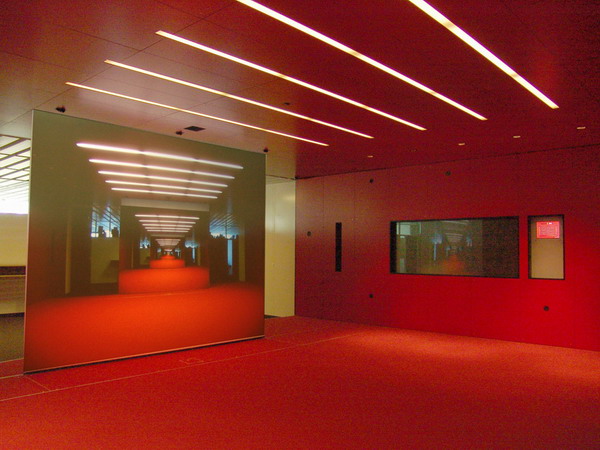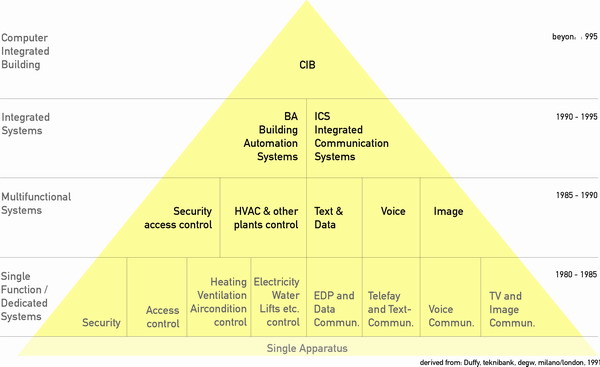
|
Article List
The Red Hell
Introduction and context
New media and modern building automation have a strong impact on contemporary architecture. So far one could regard built architecture as static. These new technologies allow a dynamic impulse to architecture.
 The objective of our research work is to demonstrate the impact of innovative systems to build architecture in daily usage while providing building automation, multimedia integration and facility management services in intelligent networked buildings. Its focus is the integration of Internet based technologies and its open and scalable standards into buildings. The idea behind is based on the concept of a ‘Computer Integrated Building’ pointed out by Frank Duffy in 1991. In the early 1990s devices and services in buildings have been comprised to integrated systems. Duffy predicated that beyond 1995 all devices and all services in buildings would be managed by and used completely through computers integrated in buildings. More than ten years later the idea of computer integrated buildings is not yet implemented. But these days a lot of things are accessible through the Internet. The Internet and its open standards and technologies can be used as communication medium for computer integrated buildings.
The objective of our research work is to demonstrate the impact of innovative systems to build architecture in daily usage while providing building automation, multimedia integration and facility management services in intelligent networked buildings. Its focus is the integration of Internet based technologies and its open and scalable standards into buildings. The idea behind is based on the concept of a ‘Computer Integrated Building’ pointed out by Frank Duffy in 1991. In the early 1990s devices and services in buildings have been comprised to integrated systems. Duffy predicated that beyond 1995 all devices and all services in buildings would be managed by and used completely through computers integrated in buildings. More than ten years later the idea of computer integrated buildings is not yet implemented. But these days a lot of things are accessible through the Internet. The Internet and its open standards and technologies can be used as communication medium for computer integrated buildings.
System Architecture
This paper introduces a lab that is used both in teachings and research. The lab is running on the level of a state of the art functional prototype and comprises a complex infrastructure. The infrastructure is composed of multimedia and building automation elements. A single system consolidates all these elements. It provides services that can be used completely through Internet technologies. Altogether the lab demonstrates ways to provide services like automation, security, media, access control and data completely through internet based technologies.
 The framework implemented in the lab is a system architecture based on three layers:
The framework implemented in the lab is a system architecture based on three layers:
- The bottom layer contains generic hardware, a group of sensors and actuators. Typical sensors are buttons, motion detector or input devices. Typical actuators are lights, video devices, audio devices or projectors.
- The middle layer, often called middleware, is a software layer. Software components are controlling and managing the hardware elements of the bottom layer. As far as possible the communication of the software with the underlying hardware layer is based on internet protocols, internet technologies and bus systems. A bus system is the standard communication medium used in the area of building automation. The approach used in the lab decouples the hardware elements of each other. A light button is a sensor in the hardware layer that sends only impulses to the middleware. This decoupling allows a free configuration and programming of the middleware and therefore allows an individual reaction to impulses from the hardware layer. The middleware is providing again a communication interface to the top layer
- The top layer is interacting with the actual users of the system. It is using a simple message exchange mechanism to communicate with the middleware layer. Arbitrary applications and therefore an arbitrary number of users can be connected with the system at the same time. Each time a lamp for example is switched the impulse is transmitted to the top layer. This event triggers the middleware to notify all connected/online user interfaces. Consequently all applications are up-to-date at all the time. In an open and ubiquitous environment like this, an application can react on incoming notifications and interact with the lab individually.
This architecture distinguishes on one side generic hardware and on the other side software functions, called services. For example a microphone and a loudspeaker are two hardware devices, which can be combined in a software service called a phone
Revision r1.2 - 27 Apr 2005 - 13:56 - SteffenLemmerzahl
Parents: ArticleFrontPage
|
Copyright © 1999-2003 by the contributing authors.
All material on this collaboration platform is the property of the contributing authors.
|
| |
|

 The objective of our research work is to demonstrate the impact of innovative systems to build architecture in daily usage while providing building automation, multimedia integration and facility management services in intelligent networked buildings. Its focus is the integration of Internet based technologies and its open and scalable standards into buildings. The idea behind is based on the concept of a ‘Computer Integrated Building’ pointed out by Frank Duffy in 1991. In the early 1990s devices and services in buildings have been comprised to integrated systems. Duffy predicated that beyond 1995 all devices and all services in buildings would be managed by and used completely through computers integrated in buildings. More than ten years later the idea of computer integrated buildings is not yet implemented. But these days a lot of things are accessible through the Internet. The Internet and its open standards and technologies can be used as communication medium for computer integrated buildings.
The objective of our research work is to demonstrate the impact of innovative systems to build architecture in daily usage while providing building automation, multimedia integration and facility management services in intelligent networked buildings. Its focus is the integration of Internet based technologies and its open and scalable standards into buildings. The idea behind is based on the concept of a ‘Computer Integrated Building’ pointed out by Frank Duffy in 1991. In the early 1990s devices and services in buildings have been comprised to integrated systems. Duffy predicated that beyond 1995 all devices and all services in buildings would be managed by and used completely through computers integrated in buildings. More than ten years later the idea of computer integrated buildings is not yet implemented. But these days a lot of things are accessible through the Internet. The Internet and its open standards and technologies can be used as communication medium for computer integrated buildings.
 The framework implemented in the lab is a system architecture based on three layers:
The framework implemented in the lab is a system architecture based on three layers:
